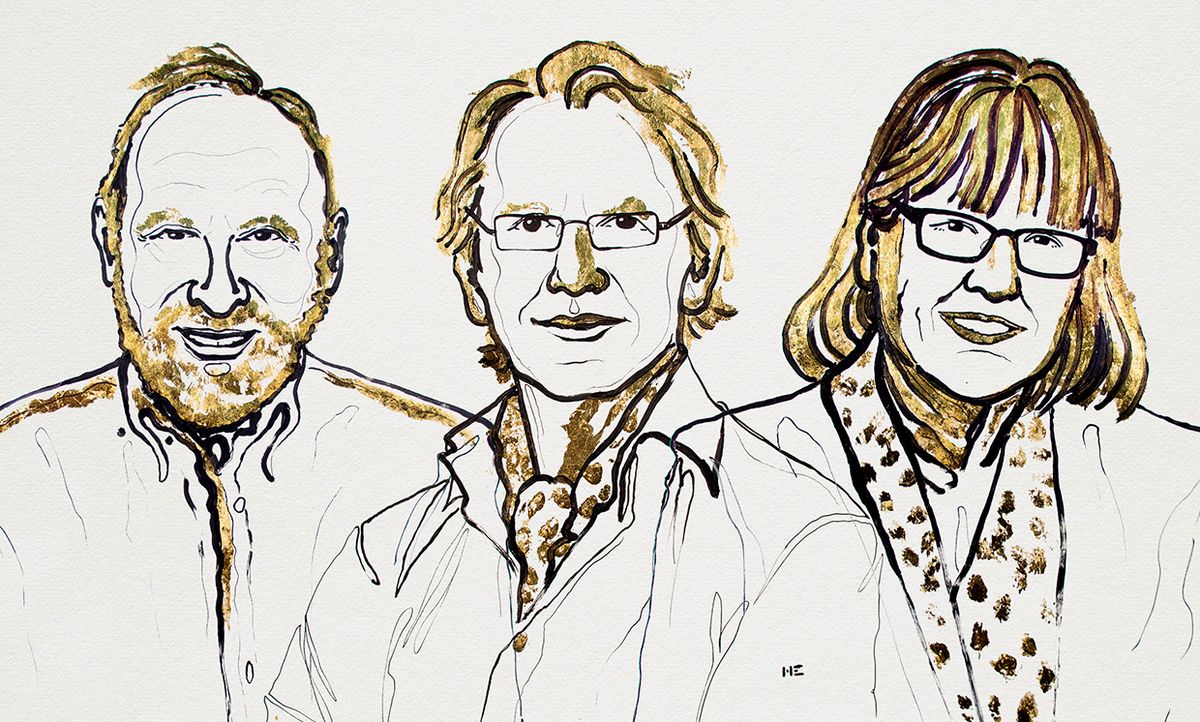The 2018 Nobel Prize in Physics honors “groundbreaking inventions in the field of laser physics” on opposite ends of the time and intensity scale. Gérard Mourou of France and Donna Strickland of Canada invented a technique called chirped-pulse amplification that generates extremely short laser pulses that reach extremely high intensity. Arthur Ashkin of the United States invented “optical tweezers,” which use low-power laser beams to manipulate tiny objects such as living cells.
Strickland, 59, is the first woman to receive a physics Nobel since Maria Goeppert-Mayer in 1963. She is a professor at the University of Waterloo in Canada whose group studies ultrafast lasers. Ashkin, an IEEE Life Fellow, is 96, making him the oldest person ever to win a Nobel Prize. Though retired from Bell Labs, he remains active in research. Mourou, 74, and also an IEEE Life Fellow, is at the Ecole Polytechnique in Paris. He has been a driving force behind the Extreme Light Infrastructure, which is building three large laser facilities based on chirped-pulse amplification.
Pulsed lasers can concentrate light onto a small area for a short time to produce very high intensities, used for applications including laser machining and research on the properties of matter under extreme conditions. Peak intensities increased rapidly for several years after Theodore Maiman demonstrated the first laser in 1960. But they plateaued for more than a decade after 1970 because amplifying light past a certain point damaged the solid, limiting possible power. Working at the University of Rochester in 1985, Strickland and Mourou invented chirped-pulse amplification to get around that limit.

Their idea, inspired by radar, was to spread the range of wavelengths present in a short pulse across a longer interval in time before amplifying it. To do that, they passed the input pulse through a pair of diffraction gratings arranged so that different wavelengths followed paths of different lengths, thus spreading the wavelengths in time so the pulse “chirped,” changing color over time. That increased the pulse duration but spread out the energy in the pulse over time, so much less power was present at any one time. The pulse then could be amplified to below the damage level, which depended on instantaneous power, but the total energy over the extended pulse would be higher than could be produced by amplifying the original short pulse.
The stretched and amplified pulse could subsequently be compressed by passing it through a second pair of diffraction gratings arranged to shorten the pulse duration. The result: peak power that would have been impossible to produce otherwise. Strickland and Mourou discovered that stretching the pulse length by orders of magnitude could increase the peak focused intensity by orders of magnitude.
The technique became the basis of Strickland's doctoral dissertation, and soon was put to use generating even shorter and more intense laser pulses. Early chirped-pulse amplification allowed tabletop lasers to produce terawatt pulses. The Lawrence Livermore National Laboratory spent a decade building a petawatt (1015 watt) laser, completed in 1999. The Extreme Light Infrastructure, spearheaded by Mourou and funded by the European Union, will include a 10-petawatt laser in Prague that is expected to produce power levels reaching 1023 watts per square centimeter. Pulse lengths can also be reduced into the attosecond (10-18 second) region. Many applications are in research, but lasers producing ultrashort, ultra-intense bursts are also being used in industry and in health care applications such as removing small amounts of tissue during eye surgery.
Working at Bell Labs in 1970, Ashkin first showed that the pressure of lasers emitting tightly focused, stable beams of light could move small particles. The following year, he showed that an upwards pointing laser beam could provide enough of a push on a small particle to offset the force of gravity. But that levitation found only limited use because other forces such as Brownian motion in water can easily push such a small particle out of the laser beam’s path. In 1986, Ashkin and a Bell Labs team including Steven Chu developed optical tweezers. Their invention featured a short-focus lens that created a strong gradient in the laser beam capable of trapping particles from tens of nanometers to tens of micrometers, even in water. That technique was soon used to demonstrate feats including laser cooling of atoms, for which Steven Chu shared the 1997 Nobel Prize in Physics.

Ashkin then turned to biological systems, showing that optical tweezers could trap and manipulate viruses and living cells. The ability to delicately manipulate cells and even subcellular structures led to a wide range of applications in biology. Optical tweezers can now be used to detect single base-pair steps along strands of DNA, and to unfold small RNA molecules. They also can study molecular motors, proteins that transport material inside living cells. This ability to probe single molecules “has opened up a new window through which we can view the molecular foundations of biology,” says the Nobel Committee.
Jeff Hecht writes about lasers, optics, fiber optics, electronics, and communications. Trained in engineering and a life senior member of IEEE, he enjoys figuring out how laser, optical, and electronic systems work and explaining their applications and challenges. At the moment, he’s exploring the challenges of integrating lidars, cameras, and other sensing systems with artificial intelligence in self-driving cars. He has chronicled the histories of laser weapons and fiber-optic communications and written tutorial books on lasers and fiber optics.



